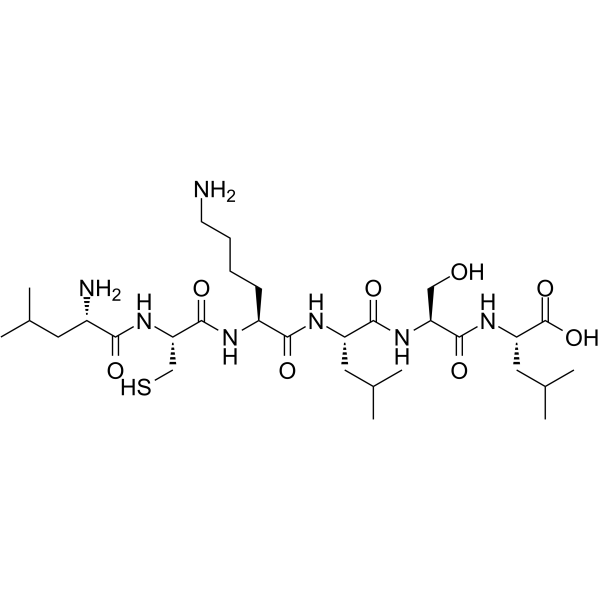
| 规格 | 价格 | 库存 | 数量 |
|---|---|---|---|
| 1mg |
|
||
| 5mg |
|
||
| 10mg |
|
||
| 25mg |
|
||
| 50mg |
|
||
| 100mg |
|
||
| 250mg |
|
||
| Other Sizes |
|
| 体外研究 (In Vitro) |
LCKLSL(0-2 mg)治疗可减少缺氧环境下人视网膜微血管内皮细胞(RMVEC)中纤溶酶的生成和 VEGF 诱导的 tPA 活性 [1]。
|
|---|---|
| 体内研究 (In Vivo) |
在两种体内血管生成模型(小鼠基质胶栓试验和鸡绒毛尿囊膜)中应用 LCKLSL 可以抑制血管生成反应。 LCKLSL 肽处理显着缩短了通道的长度。 5 μg/mL 剂量的 LCKLSL 肽可显着减少血管分支、连接处和端点 [1]。
|
| 参考文献 |
[1]. Mallika Valapala, et al. A Competitive Hexapeptide Inhibitor of Annexin A2 Prevents Hypoxia-Induced Angiogenic Events. J Cell Sci. 2011 May 1;124(Pt 9):1453-64.
|
| 分子式 |
C30H57N7O8S
|
|---|---|
| 分子量 |
675.881
|
| 精确质量 |
675.398
|
| CAS号 |
533902-29-3
|
| 相关CAS号 |
LCKLSL hydrochloride
|
| PubChem CID |
146681222
|
| 外观&性状 |
Typically exists as solid at room temperature
|
| LogP |
-2.1
|
| tPSA |
256
|
| 氢键供体(HBD)数目 |
10
|
| 氢键受体(HBA)数目 |
11
|
| 可旋转键数目(RBC) |
23
|
| 重原子数目 |
46
|
| 分子复杂度/Complexity |
998
|
| 定义原子立体中心数目 |
6
|
| SMILES |
CC(C)C[C@@H](C(=O)N[C@@H](CS)C(=O)N[C@@H](CCCCN)C(=O)N[C@@H](CC(C)C)C(=O)N[C@@H](CO)C(=O)N[C@@H](CC(C)C)C(=O)O)N
|
| InChi Key |
HTBYABHLBWELKC-BTNSXGMBSA-N
|
| InChi Code |
InChI=1S/C30H57N7O8S/c1-16(2)11-19(32)25(39)37-24(15-46)29(43)33-20(9-7-8-10-31)26(40)34-21(12-17(3)4)27(41)36-23(14-38)28(42)35-22(30(44)45)13-18(5)6/h16-24,38,46H,7-15,31-32H2,1-6H3,(H,33,43)(H,34,40)(H,35,42)(H,36,41)(H,37,39)(H,44,45)/t19-,20-,21-,22-,23-,24-/m0/s1
|
| 化学名 |
(2S)-2-[[(2S)-2-[[(2S)-2-[[(2S)-6-amino-2-[[(2R)-2-[[(2S)-2-amino-4-methylpentanoyl]amino]-3-sulfanylpropanoyl]amino]hexanoyl]amino]-4-methylpentanoyl]amino]-3-hydroxypropanoyl]amino]-4-methylpentanoic acid
|
| HS Tariff Code |
2934.99.9001
|
| 存储方式 |
Powder -20°C 3 years 4°C 2 years In solvent -80°C 6 months -20°C 1 month |
| 运输条件 |
Room temperature (This product is stable at ambient temperature for a few days during ordinary shipping and time spent in Customs)
|
| 溶解度 (体外实验) |
May dissolve in DMSO (in most cases), if not, try other solvents such as H2O, Ethanol, or DMF with a minute amount of products to avoid loss of samples
|
|---|---|
| 溶解度 (体内实验) |
注意: 如下所列的是一些常用的体内动物实验溶解配方,主要用于溶解难溶或不溶于水的产品(水溶度<1 mg/mL)。 建议您先取少量样品进行尝试,如该配方可行,再根据实验需求增加样品量。
注射用配方
注射用配方1: DMSO : Tween 80: Saline = 10 : 5 : 85 (如: 100 μL DMSO → 50 μL Tween 80 → 850 μL Saline)(IP/IV/IM/SC等) *生理盐水/Saline的制备:将0.9g氯化钠/NaCl溶解在100 mL ddH ₂ O中,得到澄清溶液。 注射用配方 2: DMSO : PEG300 :Tween 80 : Saline = 10 : 40 : 5 : 45 (如: 100 μL DMSO → 400 μL PEG300 → 50 μL Tween 80 → 450 μL Saline) 注射用配方 3: DMSO : Corn oil = 10 : 90 (如: 100 μL DMSO → 900 μL Corn oil) 示例: 以注射用配方 3 (DMSO : Corn oil = 10 : 90) 为例说明, 如果要配制 1 mL 2.5 mg/mL的工作液, 您可以取 100 μL 25 mg/mL 澄清的 DMSO 储备液,加到 900 μL Corn oil/玉米油中, 混合均匀。 View More
注射用配方 4: DMSO : 20% SBE-β-CD in Saline = 10 : 90 [如:100 μL DMSO → 900 μL (20% SBE-β-CD in Saline)] 口服配方
口服配方 1: 悬浮于0.5% CMC Na (羧甲基纤维素钠) 口服配方 2: 悬浮于0.5% Carboxymethyl cellulose (羧甲基纤维素) 示例: 以口服配方 1 (悬浮于 0.5% CMC Na)为例说明, 如果要配制 100 mL 2.5 mg/mL 的工作液, 您可以先取0.5g CMC Na并将其溶解于100mL ddH2O中,得到0.5%CMC-Na澄清溶液;然后将250 mg待测化合物加到100 mL前述 0.5%CMC Na溶液中,得到悬浮液。 View More
口服配方 3: 溶解于 PEG400 (聚乙二醇400) 请根据您的实验动物和给药方式选择适当的溶解配方/方案: 1、请先配制澄清的储备液(如:用DMSO配置50 或 100 mg/mL母液(储备液)); 2、取适量母液,按从左到右的顺序依次添加助溶剂,澄清后再加入下一助溶剂。以 下列配方为例说明 (注意此配方只用于说明,并不一定代表此产品 的实际溶解配方): 10% DMSO → 40% PEG300 → 5% Tween-80 → 45% ddH2O (或 saline); 假设最终工作液的体积为 1 mL, 浓度为5 mg/mL: 取 100 μL 50 mg/mL 的澄清 DMSO 储备液加到 400 μL PEG300 中,混合均匀/澄清;向上述体系中加入50 μL Tween-80,混合均匀/澄清;然后继续加入450 μL ddH2O (或 saline)定容至 1 mL; 3、溶剂前显示的百分比是指该溶剂在最终溶液/工作液中的体积所占比例; 4、 如产品在配制过程中出现沉淀/析出,可通过加热(≤50℃)或超声的方式助溶; 5、为保证最佳实验结果,工作液请现配现用! 6、如不确定怎么将母液配置成体内动物实验的工作液,请查看说明书或联系我们; 7、 以上所有助溶剂都可在 Invivochem.cn网站购买。 |
| 制备储备液 | 1 mg | 5 mg | 10 mg | |
| 1 mM | 1.4796 mL | 7.3978 mL | 14.7955 mL | |
| 5 mM | 0.2959 mL | 1.4796 mL | 2.9591 mL | |
| 10 mM | 0.1480 mL | 0.7398 mL | 1.4796 mL |
1、根据实验需要选择合适的溶剂配制储备液 (母液):对于大多数产品,InvivoChem推荐用DMSO配置母液 (比如:5、10、20mM或者10、20、50 mg/mL浓度),个别水溶性高的产品可直接溶于水。产品在DMSO 、水或其他溶剂中的具体溶解度详见上”溶解度 (体外)”部分;
2、如果您找不到您想要的溶解度信息,或者很难将产品溶解在溶液中,请联系我们;
3、建议使用下列计算器进行相关计算(摩尔浓度计算器、稀释计算器、分子量计算器、重组计算器等);
4、母液配好之后,将其分装到常规用量,并储存在-20°C或-80°C,尽量减少反复冻融循环。
计算结果:
工作液浓度: mg/mL;
DMSO母液配制方法: mg 药物溶于 μL DMSO溶液(母液浓度 mg/mL)。如该浓度超过该批次药物DMSO溶解度,请首先与我们联系。
体内配方配制方法:取 μL DMSO母液,加入 μL PEG300,混匀澄清后加入μL Tween 80,混匀澄清后加入 μL ddH2O,混匀澄清。
(1) 请确保溶液澄清之后,再加入下一种溶剂 (助溶剂) 。可利用涡旋、超声或水浴加热等方法助溶;
(2) 一定要按顺序加入溶剂 (助溶剂) 。
|
|